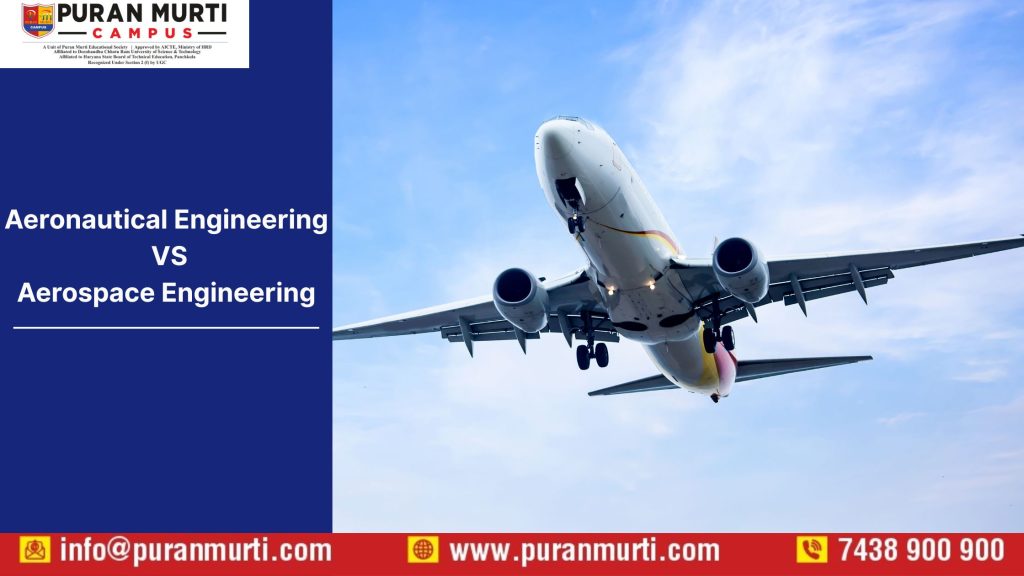Aeronautical Engineering vs Aerospace Engineering
Posted on : 21 April, 2025 11:56 am
Engineering assists in steering innovation and contemporary advancements. Civil engineers, for instance, provide society with safe infrastructure, while computer engineers design hardware and software that enable individuals to accomplish things quicker and better. Other branches of engineering ― aeronautical engineering vs aerospace engineering, for example ― have facilitated the transportation of individuals to any place on earth. Airplanes are a cornerstone of global supply chains, enabling goods to be shipped from nation to nation more quickly than by conventional means, including ocean freighters and trains.
A comparison of aerospace engineering and aeronautical engineering shows that technologies in contemporary transport, including aircraft and space shuttles, influence economic processes and facilitate social well-being. Due to aeronautical engineers and aerospace engineers, there have been improvements in exploration, a major element in innovation. These engineers help minimize the risks associated with exploration, while arriving at discoveries that benefit society, from using drones to track weather events to helping develop the International Space Station.
These two engineering branches go together. However, a comparison of aeronautical engineers vs. aerospace engineers shows important distinctions ― specifically, the kinds of engineering projects they do and the subjects the various academic programs emphasize. This data is valuable to people choosing which engineering profession to enter.
What Is an Aeronautical Engineer?
When Orville and Wilbur Wright made powered, sustained flight of an airplane a reality in the 19th century, they probably did not anticipate how their engineering achievement would revolutionize the contemporary world ― and contribute to the development of the thrilling discipline of aeronautical engineering.
Aeronautical engineering involves designing, prototyping, manufacturing, and testing all forms of flight-capable machines within the atmosphere of the Earth, from civilian airplanes and drones to airborne military vessels and helicopters.
Aeronautical engineers integrate sciences, including physics and aerodynamics, with their technology design and electromechanical capabilities to construct prototypes, propulsion units, and structural materials for planes. In addition, they also make sure that the systems they construct and design work as required through mathematical modeling, engineering theories, and experimentation. Aeronautical engineering is also concerned with flight technology as well as how to work with the aerodynamic form of wings.
As part of the design process, aeronautical engineers include aspects like budget analysis to reduce cost overruns, which in airplane design can be in millions of dollars. They also have to track and adhere to safety standards, such as those from the U.S. Federal Aviation Administration. Like in any field of engineering, problem-solving is central to aeronautical engineering careers. For instance, an aeronautical engineer could be asked to design a system that would be both fuel efficient and yet high in performance.
What Is an Aerospace Engineer?
In the later years of the 1950s, engineers started designing planes that flew faster and farther than ever before, into the upper atmosphere and even into space. The USSR put the first artificial satellite, Sputnik, into orbit in 1957. Explorer I, the first U.S.-launched satellite, assisted in the discovery of Van Allen radiation belts around Earth the next year.
Aerospace engineering enables such developments, with an emphasis on designing, prototyping, manufacturing, and testing aircraft systems that operate in Earth’s upper atmosphere and space. They include rockets, missiles, and satellites. Similar to aeronautical engineers, aerospace engineers integrate their understanding of mathematical models, engineering principles, and testing procedures to make the systems they design and build work properly and safely.
Aerospace engineers can specialize in a particular field related to flying and aerospace. For instance, they could specialize in jet propulsion: the thrust that accelerates an object like a rocket in a direction, generated by the expulsion of a stream (or jet) of fluid in the opposite direction. Another specialization is aerodynamics, the physics of air flow around objects like wings.
As part of their engineering process, aerospace engineers draw on their knowledge of structural design, navigation instruments, robotics, and combustion in order to handle large-scale engineering projects. It usually involves collaboration with other engineers, such as electrical, computer, and systems engineers, who utilize their skills in designing spacecraft, aircraft, and rockets.
Difference Between Aeronautical Engineers and Aerospace Engineers
In the aeronautical engineer versus aerospace engineer, the main difference is that aeronautical engineers specialize in flight within the atmosphere, whereas aerospace engineers specialize in space and atmospheric flight. In other words, whereas aeronautical engineers develop aircraft that travel within Earth’s atmosphere, aerospace engineers develop aircraft and spacecraft that operate both within the atmosphere and in outer space.
This difference can be seen in an engineer’s education. Typical subjects taught in aeronautical engineering classes are the study of thermodynamics, heat transfer, airplane structures, and mechanical control and stability. Aerospace engineering classes build upon those subjects to examine the impact of airplanes flying above the atmosphere, such as jet propulsion, spacecraft design, and orbital mechanics.
Aeronautical engineering is usually distinguished as a subspecialty within aerospace engineering because it addresses only one aspect of aerospace. Astronautical engineering, another subdivision of aerospace engineering, addresses craft designed to operate in outer space.
Similarities Between Aeronautical Engineers and Aerospace Engineers
In every area of aerospace engineering, an understanding of project management is necessary in order to see that work gets done on time, costs are controlled, and coordination among various engineering teams works well.
These two positions also have extremely comparable salaries. The median yearly wage for aerospace engineers, including aeronautical engineers and astronautical engineers, was $122,270 as of May 2021, reported by the U.S. Bureau of Labor Statistics. But a more detailed look at aeronautical engineer versus aerospace engineer salaries does show some variations by location and other variables. For instance, aeronautical engineers in the Seattle region receive higher average salaries ― 31% above the national median as of May 2022, according to Payscale, while aerospace engineers in Seattle receive only 14% above the national median.

